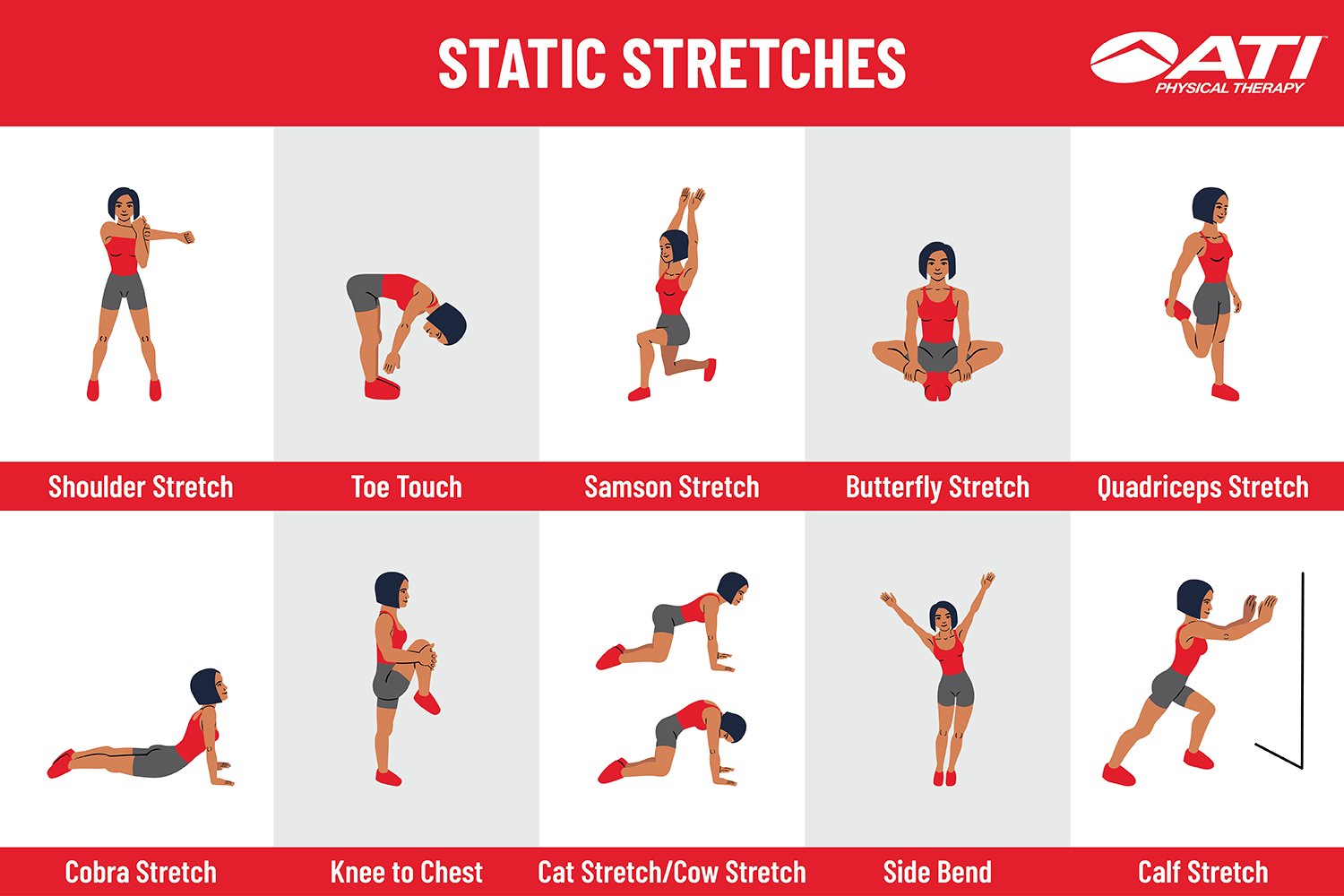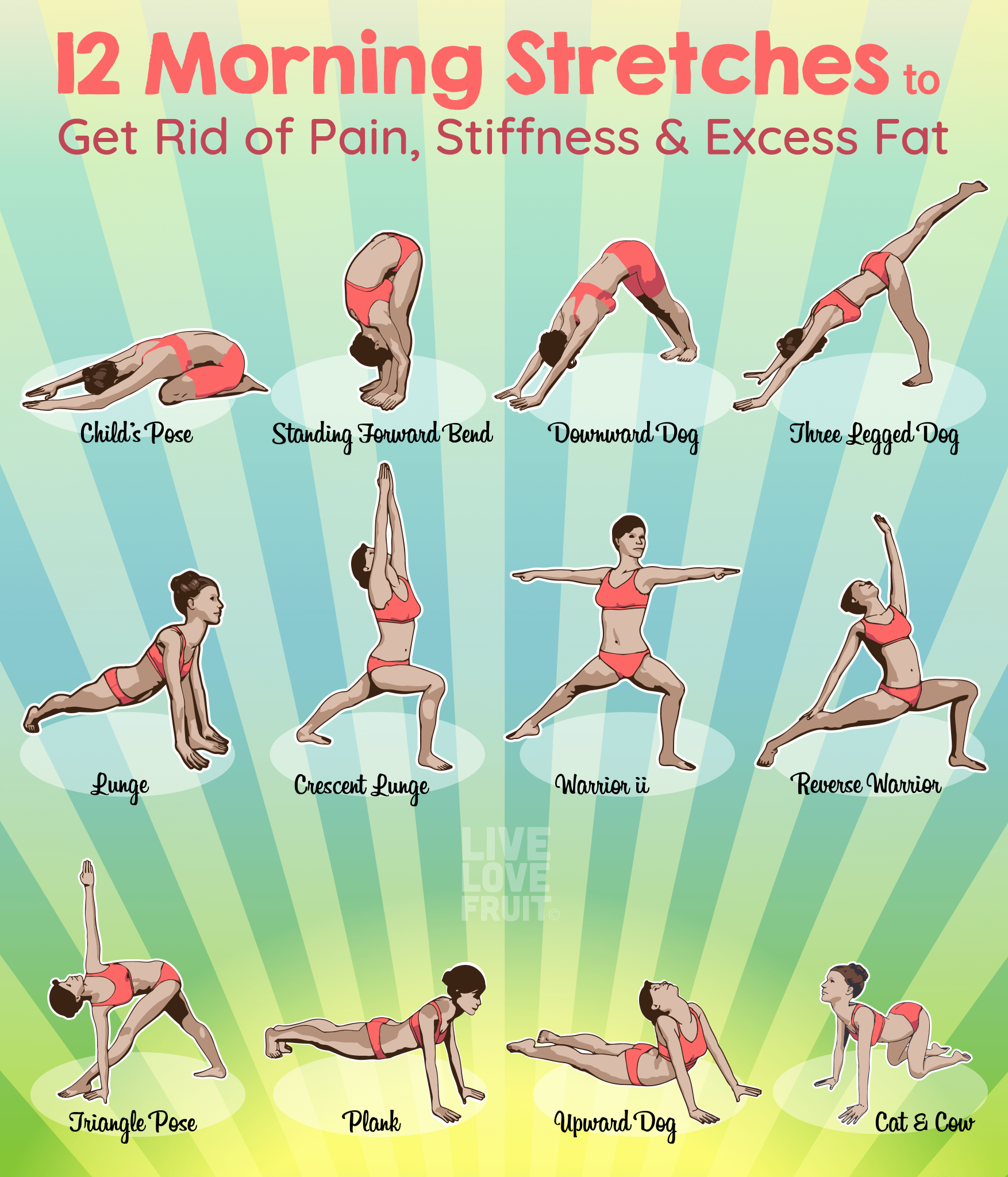You should warm up by doing dynamic stretches, which are like your workout but at a lower intensity. A good warm-up before a run could be a brisk walk, walking lunges, leg swings, high steps, or "butt kicks" (slowly jogging forward while kicking toward your rear end). Start slowly, and gradually ramp up the intensity.
How do you loosen up muscles before working out?
Try these seven dynamic stretches that can help you warm up before your next workout.
- Hip Circles. Stand on one leg, using a countertop for support, and gently swing the opposite leg in circles out to the side.
- Arm Circles.
- Arm Swings.
- High-Stepping.
- Heel-to-Toe Walk.
- Lunges with a Twist.
- Step Up and Over.
Does stretching before workout help build muscle?
Theoretically, stretching before exercise should make the muscles more pliable and less likely to tear. But when studies have compared rates of injury or muscle soreness in people who stretch before exercise and those who don't, they have found little benefit to stretching.
Can I stretch 30 minutes before workout?
You can stretch both before and after lifting weights. In your pre-weight lifting session stretch, make sure to warm up the muscles you'll actually be working. Stretching after strength training is a good idea to help you prevent soreness and prepare yourself for your next workout.
Is it OK to not stretch before working out?
While some evidence is conflicting, the majority of research also suggests that static stretching has no effect on — or may even hinder — your performance during strength and power training. (Power training involves performing moves like jumps or explosive lifts to work on both speed and strength.)
What kind of stretching is good before a workout?
Dynamic stretch
But studies suggest a dynamic stretch is just as effective, and sometimes better, especially before your workout. A dynamic stretch, like the Standing Cat-Camel, moves a muscle group fluidly through an entire range of motion.



I do this exercise before every workout.
— Dan Go (@FitFounder) July 28, 2020
It's called the World's Greatest Stretch because it does a lot in a little amount time.
In 60 seconds it'll mobilize your hips, hamstrings, calves & upper back.
Watch the vid, do this before a workout & your body will thank you. pic.twitter.com/5P0Crattnm
Is it better to stretch or warm up before a workout?
It is very important that you perform the general warm-up before you stretch. It is not a good idea to attempt to stretch before your muscles are warm (something which the general warm-up accomplishes). Warming up can do more than just loosen stiff muscles; when done properly, it can actually improve performance.
Frequently Asked Questions
Should I stretch before or after gym?
Preparing your body for activity by doing dynamic stretches before you work out may minimize your risk of injury. When you have good flexibility and a full range of motion in all of your joints, your body is better able to distribute loads and forces that it encounters as you move, says Dr. Kimbrough. Pain relief.
Which of the 4 types of stretching is not recommended?
Ballistic Stretching
(e.g. bouncing down repeatedly to touch your toes.) This type of stretching is not considered useful and can lead to injury.
Is static stretching good before workout?
While some evidence is conflicting, the majority of research also suggests that static stretching has no effect on — or may even hinder — your performance during strength and power training.
Which form of stretching is most effective before exercise?
To avoid decrease in strength and performance that may occur in athletes due to static stretching before competition or activity, dynamic stretching is recommended for warm-up.
What is the best order to stretch in?
As a general rule, you should usually do the following when putting together a stretching routine:
- Stretch your back (upper and lower) first.
- Stretch your sides after stretching your back.
- Stretch your buttocks before stretching your groin or your hamstrings.
- Stretch your calves before stretching your hamstrings.
Should stretching be performed before a workout?
Stretching before a workout can make your muscles looser and warm up the body, however, stretching after accomplishes both of those benefits while also increasing blood flow which helps with muscle recovery from either an intense or light workout. The best time to stretch is after a workout.
FAQ
- What type of stretching should be done before a workout?
- But studies suggest a dynamic stretch is just as effective, and sometimes better, especially before your workout. A dynamic stretch, like the Standing Cat-Camel, moves a muscle group fluidly through an entire range of motion.
- Should I stretch before my workout?
- A pre-workout stretch can prevent injury. Stretching before a game or race can hinder performance. But don't let the confusion dissuade you from stretching. “It's beneficial to stretch both before and after your workout,” says Mary Kimbrough, PT, DPT, OCS, a physical therapist at Hinge Health.
- What stretching should I do before and after a workout?
- Dynamic stretching is best for before your workout, while static stretching is best for a cool-down after your workout. There are various types of stretches that fall within each category to try.
- Is it better to stretch or warm-up before a workout?
- It is very important that you perform the general warm-up before you stretch. It is not a good idea to attempt to stretch before your muscles are warm (something which the general warm-up accomplishes). Warming up can do more than just loosen stiff muscles; when done properly, it can actually improve performance.
- What type of stretching should you do before workout?
- There are different types of stretching for before your workout and after. Dynamic stretching is best for before your workout, while static stretching is best for a cool-down after your workout.
What type of stretching is best before a workout
| Is it better to do dynamic or static stretching before exercise? | Before a workout, try incorporating dynamic stretches into an active warmup. This can include sprints, jump rope, or any combination of stretches that involve continuous movement. After your workout is complete, use static stretches to bring your heart rate down and relax your muscles. |
| Is it better to stretch before or after lifting weights? | Stretching before a workout can make your muscles looser and warm up the body, however, stretching after accomplishes both of those benefits while also increasing blood flow which helps with muscle recovery from either an intense or light workout. The best time to stretch is after a workout. |
| How do you prepare for stretching exercises? | You may hurt yourself if you stretch cold muscles. Before stretching, warm up with light walking, jogging or biking at low intensity for 5 to 10 minutes. Even better, stretch after your workout when your muscles are warm. |
| How to stretch correctly? | Here are some tips on how to stretch properly:
|
| What kind of stretcing shoulf i do before a workout | Jan 4, 2023 — Dynamic Stretches: Warm-up Stretches / Pre-Workout Stretches · 1. Squats · 2. High knees · 3. Leg swings · 4. Lunges · 5. Plank walk-outs · 6. Arm |
- What type of stretching is best before a workout?
- Dynamic stretches Experts recommend dynamic stretches before a workout and static stretches after a workout.
- Do experts recommend stretching prior to your workout?
- Glenn Harris, Boston University Athletics head strength and conditioning coach. I suggest that people go through a dynamic stretching routine instead of a static stretching routine prior to exercising. Bringing the body through a range of motion can actually prepare it for the demands of the exercise session.
- What type of stretches should you do before a workout?
- Dynamic stretches are more sports-specific and functional than static stretches. They reflect the motions you do during your preferred exercise regimen or sport. Dynamic stretches prepare the body for high-intensity activity, which is why they should be done before you work out.
- Is it better to workout before static or dynamic stretching?
- Both static and dynamic stretching can be beneficial. But you use the two techniques during different parts of your workout. Dynamic stretching uses active movements to prepare muscles for exercise. Static stretching involves holding muscles in one position to increase flexibility after exercise.
- What are the 4 different types of stretching?
- There are four types of stretching – active stretching, passive stretching, dynamic stretching, and proprioceptive neuromuscular facilitation (PNF) stretching, which involves table stretching.

